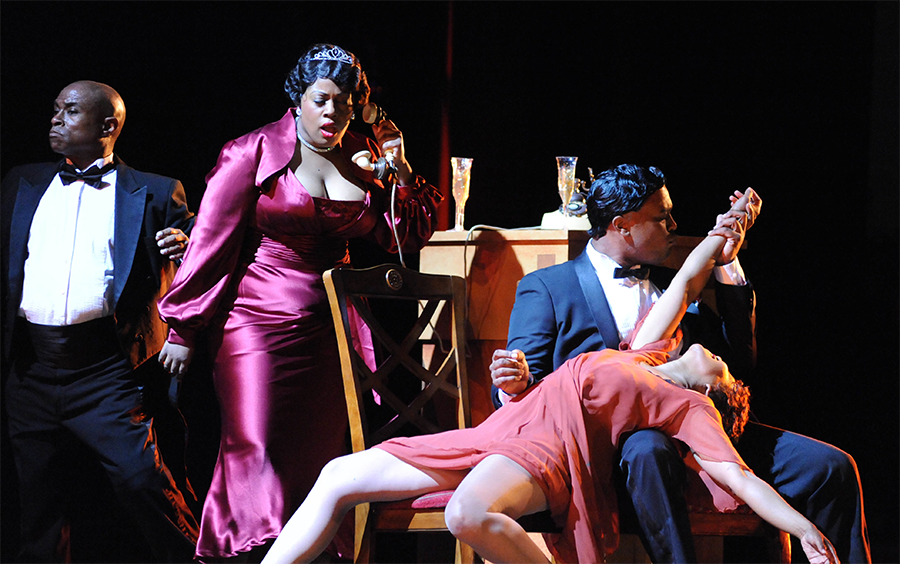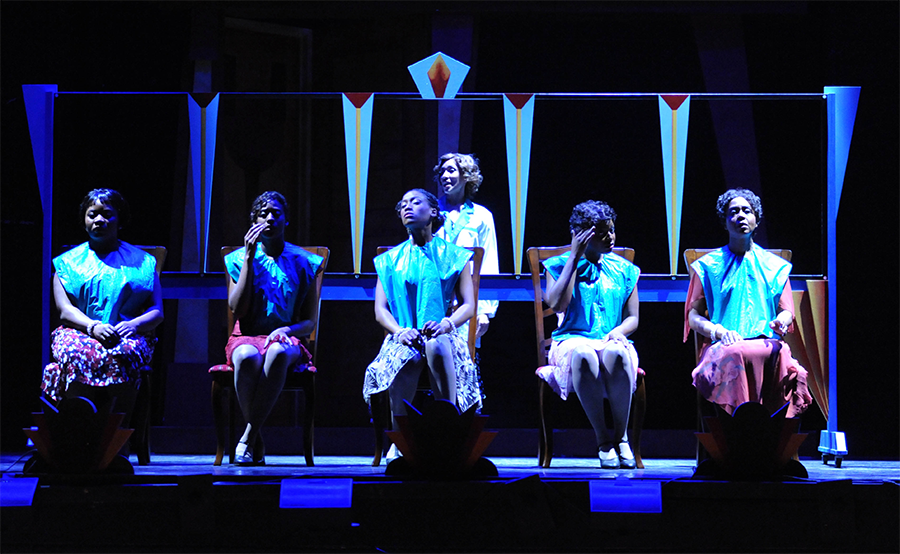
Photos courtesy of Long Beach Opera
Calling Queenie Pie an opera is a bit of a stretch, even though a considerable amount of the show is sung. Calling it a musical in a conventional sense, however, is also a bit of a stretch, as the show’s narrative is more suggestive and impressionistic than it is straightforward. It is also not a jazz concert, although at many times throughout the evening, if you were to close your eyes and listen to the swinging orchestra or the impeccable cast, you would be forgiven for assuming as much.
Queenie Pie, then, is a bit of an enigma. Written by the great Duke Ellington (with a libretto by Betty McGettigan and additional material by Tommy Shepherd and Ken Roht) from the years of 1967 to 1974 under commission from NYC Public Television, the piece was originally conceived to be a vehicle for jazz great Lena Horne. Due to a loss of funds, unfortunately, the piece never fully materialized, and the transition from his hour-long version that was to air on television to the full length “Street Opera” of Ellington’s dreams never came to completion. This means that we now must add “unfinished” to the list of things that Queenie Pie inherently both is and isn’t.
The Long Beach Opera, one of the most forward thinking and progressive artistic voices in our fair city, has now taken on Queenie Pie as the opening to it’s 35th season, a cause for both celebration and debate; celebration due to the wealth of wonderful sounding music and the exceedingly handsome production/cast at hand, and debate because the “opera” still feels unfinished at times, especially towards its ending, which raises questions about whether unfinished works should be presented in fully mounted stagings rather than in semi-staged readings or more concert oriented productions.
More on that a bit later. For now, let’s focus on the good stuff, and dear reader, there is plenty of it.
I must state right off the bat that the production currently on stage at the insanely gorgeous (and perfectly suiting) art deco Warner Grand Theater in San Pedro is very impressive. Besides some issues with sound on opening night, the only beef I had with the show at all was in relation to its source material, not the fruits of Long Beach Opera’s labor.

The plot of Queenie Pie is not its strongest suit, though the Long Beach Opera does a good job of trying to find some topical and poignant moments within the opera’s slight narrative infrastructure. Queenie, whose character is based on the real life C.J. Walker–“the first female, African-American, self-made millionaire”–has been at the top of the beauty product game for years. With the Harlem Renaissance roaring all around her, she has found a comfortable place for herself at the top of her field.
As the action starts, Queenie is challenged by a new competitor on the beauty product front, the lighter-skinned Creole woman Cafe O’Lay. The differences between the two women’s approach is apparent in both their physical appearance and the products that they manufacture, with Queenie’s products seemingly enhancing one’s natural beauty and O’Lays bleaching or lightening one’s skin tone to be more “acceptable.” When a man comes in between the two competitors, tragedy strikes, and the rest you will just have to discover for yourself. I stress again that Queenie Pie is not really about it’s plot at all; it’s about the production and the music, and if you can look past its shortcomings and towards those attributes, you will find much to celebrate.
{loadposition latestlife}
The set (Danila Korogodsky), costumes (Dabney Ross Jones) and lights (Brandon Baruch) each fit the space and the performance perfectly. Through almost all of the first act and on through much of the second I kept noticing how beautiful everything was, which is even more impressive when you consider the short amount of time the Long Beach Opera has to get something up and on its feet.
The staging is also quite stunning, with a fluid and smart sense of rhythm and flow and some surprisingly inventive choreography. Director and choreographer Ken Roht knows when to make the stage feel alive and vibrant and when to strip that all away and rely on the vocal and acting chops of his cast to convey the music and emotions on display. Unlike in much opera I’ve seen, Roht also knows how to have his cast interact with each other like real people. Even though the characters in Queenie Pie are more archetypal than actual, Roth and his amazing cast know how to make these characters at least behave like people you might actually know or meet. These people look into each other’s eyes when they sing to each other. They make jokes, riff and scat, and most importantly, they touch each other when they are trying to convey an emotion or a thought, something that so often is lost in the great melodramatic world of opera. Everyone involved should be commended on how consistently convincing Queenie Pie is on this level, even if the actual happenings can sometimes feel unfinished or contrived.
What does not feel unfinished or contrived in any way is the cast and orchestra of Queenie Pie, who are, to put it mildly, spectacular. Every instrument in the pit (conducted with great skill by Jeffrey Lindberg) and every voice on the stage are cause for celebration. Even opening night’s faulty micing couldn’t hide that fact. The music all sounds great. Even the lesser songs of Queenie Pie and the jingles that constantly appear throughout the performance sound so good you likely won’t want them to stop. I only wish that the band could have somehow been placed on the stage like the big bands that the Duke was so famous for leading. It would have been wonderful to see the orchestra as they played and I think placing them behind or on risers above the action on stage would have made it easier for the audience to hear some of the singers at times, making the microphones less mandatory, something I think is always important to consider.
I have rarely walked away from a show as happy with a cast as I was with this one. I would not have changed anyone. Everyone not only had the vocal chops to carry their roles (and then some in a lot of cases), but the acting was also top notch all around. Jeffrey Polk as Lil’ Daddy and the Witch Doctor is a great physical actor and a fantastic comedic presence. Keithon Gipson (Holt Faye and The King) sings beautifully and delivers all of his dialogue with proper weight and empathy. It is the two leading ladies however that really bring the house down.

Anna Bowen is a complex and haunting Cafe O’Lay, always making us aware that there is more going on inside of her emotionally than what she lets on, and creating a three dimensional character out of an archetype. When she sings of heartbreak, you believe it, and when she smiles, you’ll smile as well.
The true star of the evening however, is Karen Marie Richardson as Queenie Pie. She delivers a performance that would make the show worth seeing if for her alone. She owns Queenie from the second she steps on stage, and paints her with such varying levels of complexity that you are often left in awe. Her voice, a beautiful jazzy and sultry beast, has traces of Holiday, Fitzgerald, Horne and even Winehouse in its DNA, but it belongs to her and to her alone. She could scat me the whole Webster’s Dictionary and I would likely pay money to see it. Any time she is on stage, she caries the whole show on her shoulders like Atlas carries the world, and you will likely be glad to take it from her at any moment as if it were a feather pillow.
{loadposition latestartsandculture}
Queenie Pie, as I have said many times, is an uneven work. The second act goes in and out of feeling cohesive and at odds with itself, some songs feel more like thoughts or fragments (which they most likely are) than actual songs, and there are times when the plot progresses in ways that don’t really make much sense. If these are the kind of things that can ruin a night at the theater for you however, you likely aren’t an opera fan to begin with (just try to make logical narrative sense out of something like “The Magic Flute” for example). Queenie Pie is unfinished, even though it is finished, but you don’t have to accept that fact in order to enjoy the Long Beach Opera’s current production. Though Queenie Pie may have felt more comprehensive as a staged reading or concert version without the full sets and staging, it is a pleasure for the most part to see what the LBO has come up with.
Often, it’s ambiguities lift it from the confines of the tangible, and lift it into the reals of the metephorical. It is at these moments that the piece feels most alive, teetering on the brink of greatness somewhere between the Duke’s pen, the Harlem Renaissance, and now. Anyone with a love of jazz, opera or musicals and anyone with a curiosity towards what progressive performing arts in this city today looks like will have lots to relish and enjoy here.
If you get yourself across the Vincent Thomas this weekend, step into one of the last remaining Deco theaters in the Los Angeles area, and surrender all your nitpicking to Queenie Pie‘s syncopations and swing. I’m nearly positive that you will be happy that you did.
Queenie Pie’s next performances are on February 1 at 8PM and February 2 at 2PM at the Warner Grand Theatre, 478 W. 6th Street, San Pedro. To purchase tickets, visit http://www.longbeachopera.org or call (562) 432-5934
{FG_GEOMAP [33.7389776,-118.28697119999998] FG_GEOMAP}

